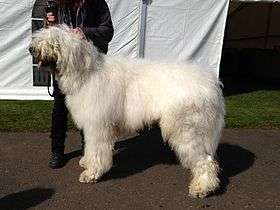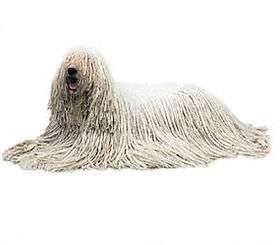Komondor
The Komondor (in Hungarian, the plural form of komondor is komondorok[1]), also known as the Hungarian sheepdog, is a large, white-coloured Hungarian breed of livestock guardian dog with a long, corded coat.
| Komondor | |||||||||
|---|---|---|---|---|---|---|---|---|---|
 Komondor | |||||||||
| Other names | Hungarian Commonmop Hungarian Sheepdog Mop Dog | ||||||||
| Origin | Hungary | ||||||||
| |||||||||
| Dog (domestic dog) | |||||||||
Sometimes referred to as 'mop dogs', the Komondor is a long-established[2] dog breed commonly employed to guard livestock and other property. The Komondor was brought to Europe by the Cumans[3] and the oldest known mention of it is in a Hungarian codex from 1544.[2] The Komondor breed has been declared one of Hungary’s national treasures, to be preserved and protected from modification.[4]
Etymology and history
Komondorok were brought to Hungary by Cumans, the Turkic speaking, nomadic people who settled in Hungary during the 12th and 13th century. The name Komondor derives from Koman-dor, meaning "Cuman dog". The breed descends from Tibetan dogs and came from Asia with the Cumans, whose homeland might have been near the Yellow River. In the late 10th century, Mongols began to expand their territories at the expense of the Cumans, forcing them to move westwards. Fleeing from the Mongols, they reached the borders of Hungary in the 12th centuries. Cumans were granted asylum and settled in Hungary in 1239 under Köten Khan.[3] Komondor remains have been found in Cuman gravesites. The name "quman-dur" means "belonging to the Cumans" or "the dog of the Cumans", thus distinguishing it from a similar Hungarian sheepdog breed which later merged with the Komondor. The name Komondor is found for the first time written in 1544 in the History of King Astiagis by Kákonyi Péter, in Hungarian. Later, in 1673, Amos Comenius mentions the Komondor in one of his works.[5] Today, the Komondor is a fairly common breed in Hungary, its country of origin. Many Komondors were killed during World War II and local stories say that this was because when the Germans (and then the Russians) invaded, they had to kill the dog before they could capture a farm or house that it guarded.


The Komondor is related to the South Russian Ovcharka, the Puli and, by extension, the Pumi, the Mudi, the Polish Lowland Sheepdog, the Schapendoes, the Bearded collie, and the Old English sheepdog.[6] In 1947, the Komondor was used to acquire fresh blood in the rare South Russian Ovcharka. In the 1970s, another Komondor cross was made.[7] It is also believed to be related to the Briard, the Catalonian Sheepdog, the Cão da Serra de Aires, the Pyrenean Shepherd and the Bergamasco shepherd, but the Bergamasco has flocks unlike the Komondor.[8]
The two Hungarian breeds of livestock guardian dogs have evolved independently. This is because the Komondor was developed by a race of people who called it the Kuman-dor, the dog of the Cumans, and the Kuvasz was bred by a different people - the Magyars. For much of Hungary's early history, these two peoples lived in separate areas in Hungary, spoke different languages and so did not mix. As a result, their dogs have little, if any at all, admixture.
Description
The Komondor is a large molosser dog—many are over 30 inches (76 cm) tall—one of the larger breeds of dog. The body is covered with a heavy, matted, corded coat. They have robust bodies, strongly muscled with long legs and a short back. The tail is carried with a slight curl. The body when seen sideways, forms a prone rectangle. The length of body is slightly longer than the height at the withers, approximately 104% of the height at withers. The Komondor has a broad head with the muzzle slightly shorter than half of the length of the head with an even and complete scissor bite. Nose and lips are always black.[9][10][11][12]
The minimum height of female Komondors is 25.5 inches (65 cm) at the withers, with an average height of 27.5 inches (70 cm). The minimum height of male Komondors is 27.5 inches (70 cm) with an average height of 31.5 inches (80 cm). No upper height limit is given.[10] Komondor females on average weigh between 88–110 lb (40–50 kg) and Komondor males weigh on average between 110–132 lb (50–60 kg).[9][11]
Appearance

The Komondor's coat is long, thick, and strikingly corded white coat, about 20 – 27 cm long (the heaviest amount of fur in the canine world), which resembles dreadlocks or a mop. The puppy coat is soft and fluffy. However, the coat is wavy and tends to curl as the puppy matures. A fully mature coat is formed naturally from the soft undercoat and the coarser outer coat combining to form tassels or cords and will take about two years to form. Some help is needed in separating the cords so the dog does not turn into one large matted mess. The length of the cords increases with time as the coat grows. Moulting is minimal with this breed, contrary to what one might think (once cords are fully formed). The only substantial shedding occurs as a puppy before the dreadlocks fully form. The Komondor is born with only a white coat,[13] unlike the similar-looking Puli, which can be white, black, or sometimes grayish. However, a working Komondor's coat may be discolored by the elements and may appear off-white if not washed regularly. Traditionally, the coat protects the Komondor from possible wolves' bites as the bites would not penetrate the thick coat.[14] The coat of the Komondor takes about two and a half days to dry after a bath.
Temperament
The Komondor is built for livestock guarding. Its temperament is like that of most livestock guarding dogs; it is calm and steady when things are normal, but, in case of trouble, the dog will fearlessly defend its charges. It was bred to think and act independently and make decisions on its own.[1]
The Komondor is affectionate with its family,[2][13] and gentle with the children and friends of the family. Although wary of strangers, they can accept them when it is clear that no harm is imminent,[15] being instinctively very protective of its family, home, and possessions.[13] The Komondor is very good with other family pets, often very protective over them, but is intolerant to trespassing animals and is not a good dog for an apartment. The dog is vigilant and will rest in the daytime, keeping an eye on its surroundings, but at night is constantly moving, patrolling the place, moving up and down around its whole territory.[2] The dogs will usually knock down intruders and keep them down until its owner arrives.[2] Hungarian Komondor breeders used to say that an intruder may be allowed to enter the property guarded by a Komondor, but he will not be allowed to leave or escape.[2]
Uses
The breed has a natural guardian instinct and an inherent ability to guard livestock.[16] An athletic dog, the Komondor is fast and powerful and will leap at a predator to drive it off or knock it down. It can be used successfully to guard sheep against wolves or bears. It is a big, strong dog breed, armored with a thick coat. The coat provides protection against wild animals, weather and vegetation. The coat looks similar to that of a sheep so it can easily blend into a flock and camouflage itself giving it an advantage when predators such as wolves attack. The Komondor is one breed of livestock guardian dog which has seen a vast increase in use as a guardian of sheep and goats in the United States to protect against predators such as coyotes, cougars, bears, and other predators.[1]
Training
Due to the Komondor's size, power, speed and temperament, a lack of obedience training can result in danger to others. Komondors generally take well to training if started early (ideally between 4–8 months). A Komondor can become obstinate when bored, so it is imperative that training sessions be upbeat and happy. Praise is a must, as are consistent and humane corrections. Once a Komondor gets away with unfriendly or hostile behavior, it will always think such behavior is appropriate. Therefore, consistent corrections even with a young puppy are necessary to ensure a well-adjusted adult. Socialization is also extremely important.[13] The Komondor should be exposed to new situations, people and other dogs while still a puppy. Because it is a natural guard dog, a Komondor that is not properly socialized may react in an excessively aggressive manner when confronted with a new situation or person.
Given the proper environment and care, a Komondor is a responsible, loving dog. It is devoted and calm without being sluggish. As in any breed, there is quite a range of personalities, so your needs should be outlined clearly to your breeder. An experienced breeder can try to identify that personality which would be happiest as an independent livestock dog, or that which wants more to please and would make a good obedience dog or family pet. Adolescence can be marked by changes in a Komondor's temperament, eating habits, trainability, and general attitude. Breed-specific legislation requires some breeds to be muzzled in public places. Romania is the only country that requires Komondors to be muzzled.[17]
In popular culture
Odelay is the fifth studio album by American musician Beck, released on 18 June 1996 by DGC Records. The album's cover features a Komondor jumping over a hurdle, taken by canine photographer Joan Ludwig (1914–2004) for the July 1977 issue of the American Kennel Club's Gazette.[18]
References
- "Komondor Dog Breeds". Archived from the original on 21 February 2009.
- Kovács, András; Gibizer Tibor; Udvardiné Lukács Ildikó (1996). Komondor, Kuvasz. Elek és Társa Könyvkiadó. ISBN 963-7314-33-4.
- "The early history of the Komondor". Komondor.org. Archived from the original on 8 November 2011. Retrieved 2 November 2011.
- "32/2004. (IV. 19.) OGY határozat". Hungarian Parliament. 2004. Archived from the original on 16 February 2005. Retrieved 15 March 2009.
- Komondor, kuvasz. Ujváriné Lukács Ildikó.
- "Bearded Collie Club of America". Retrieved 25 April 2016.
Its ancestors likely included herding dogs from the European continent, such as the Poland Lowland Sheepdog (Polski Owzcarek Nizinny) and the Komondor, blended with the sheep herding dogs of the British Isles.
- "South Russian Ovtcharka History". Euphoric Black Blossom. Retrieved 25 April 2016.
To maintain some semblance of breed and bloodline, these pure-breds were crossed with dogs of SRO-type but unknown heritage. In 1947 the Komondor was used to acquire fresh blood; in the [1970s] another Komondor cross was made.
- "Judging the Bergamasco Sheepdog". Bergamasco Sheepdog Club of America. Retrieved 25 April 2016.
- "FCI Komondor Standards: FCI-Standard No 53". Ari Komondor Kennel. 13 September 2000. Archived from the original on 20 February 2012. Retrieved 26 October 2014.
- "Komondor". Kutya-Tár. 11 August 2008. Retrieved 15 March 2009.
- "Komondor Breed Standard". American Kennel Club. Retrieved 15 March 2009.
- Soskin, Arthur R. (1998). "The FCI Hungarian standard". Komondor.org. Archived from the original on 27 March 2009. Retrieved 15 March 2009.
- Heaney, Richard; Therese Heaney (1995). "Komondors". K9web.com. Retrieved 15 March 2009.
- The dog selector, David Alderton, 2010, ISBN 978-91-7401-2460 or 0-7641-6365-5 or 978-07-641-6365-4.
- "About the Komondor". American Kennel Club. Retrieved 15 March 2009.
- The dog selector, David Alderton, page 1562011, ISBN 978-91-7401-2460
- "Cainii din rasa Pitbull vor fi interzisi in Romania". Adevǎrul (in Romanian). Bucharest, Romania. 26 April 2002. Archived from the original on 18 November 2009. Retrieved 16 November 2009.
- "Beck's 'All Original Collage' And How The American Kennel Club Helped Define 'Odelay'". 18 June 2016.